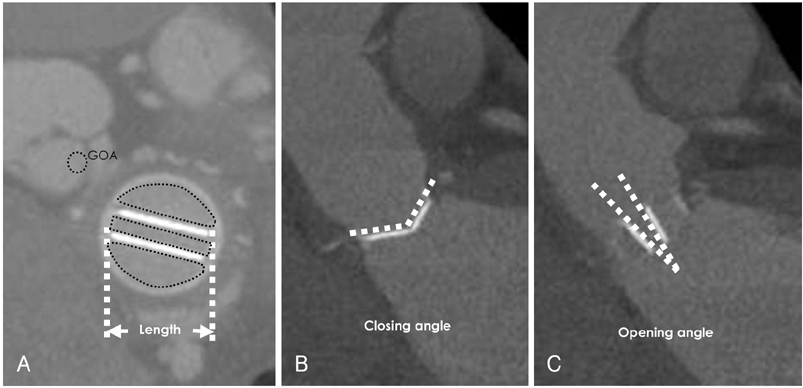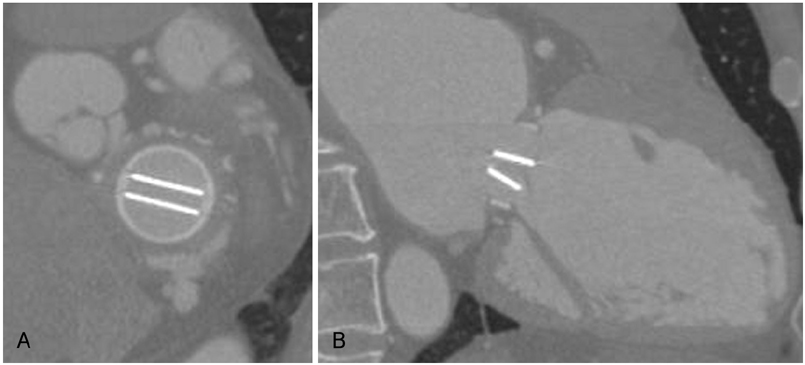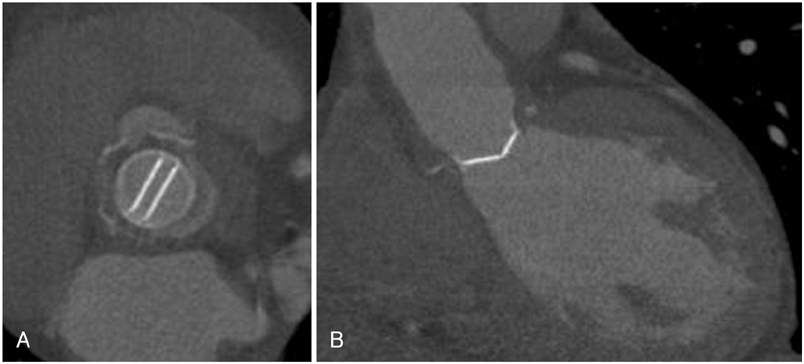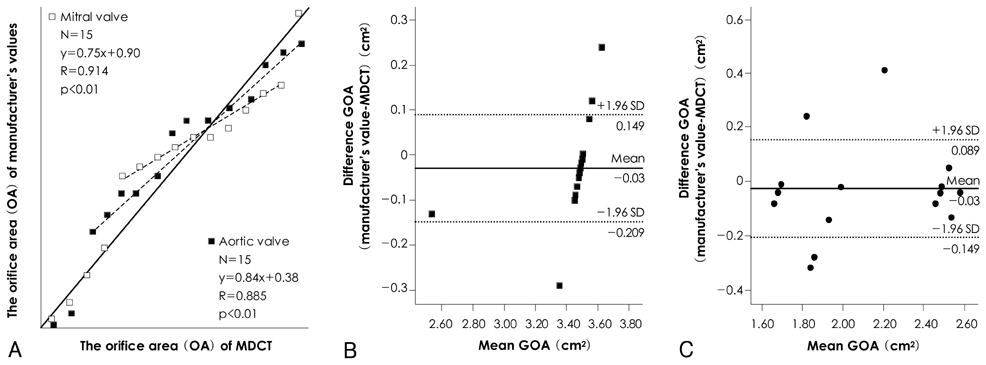Korean Circ J.
2009 Apr;39(4):157-162. 10.4070/kcj.2009.39.4.157.
The Measurement of Opening Angle and Orifice Area of a Bileaflet Mechanical Valve Using Multidetector Computed Tomography
- Affiliations
-
- 1Division of Cardiology, Department of Internal Medicine, College of Medicine, The Catholic University of Korea, Seoul, Korea. younhj@catholic.ac.kr
- 2Department of Thoracic Surgery, College of Medicine, The Catholic University of Korea, Seoul, Korea.
- 3Department of Radiology, College of Medicine, The Catholic University of Korea, Seoul, Korea.
- KMID: 2225691
- DOI: http://doi.org/10.4070/kcj.2009.39.4.157
Abstract
- BACKGROUND AND OBJECTIVES
The aim of this study was to assess mechanical valve function using 64-slice multidetector computed tomography (MDCT). SUBJECTS AND METHODS: In 20 patients (mean age, 50+/-12 years; male-to-female ratio, 10:10), 30 St. Jude bileaflet mechanical valves (15 aortic and 15 mitral valves) were evaluated using MDCT. We selected images vertical and parallel to the mechanical valve. The valve orifice area (OA) and valve length were determined by manual tracing and the opening and closing angles were measured using a protractor. The OA and length of the mechanical valves were compared with the manufacturer's values. RESULTS: The geometric orifice areas (GOAs) based on the manufacturer's values and the OAs determined by MDCT were 3.4+/-0.2 cm2 and 3.4+/-0.3 cm2 for the mitral valves and 2.1+/-0.3 cm2 and 2.1+/-0.4 cm2 for the aortic valves, respectively. The correlation coefficients between the OA measures were 0.433 for the mitral valves and 0.874 for the aortic valves (both p<0.001). The lengths based on the manufacturer's values and determined by MDCT were 29.3+/-1.99 mm and 29.6+/-1.65 mm for the mitral valves and 21.5+/-2.1 mm and 20.7+/-2.3 mm for the aortic valves, respectively. The correlation coefficients between the measures were 0.651 for the mitral valve and 0.846 for the aortic valve (both p<0.001). The opening and closing angles determined by MDCT were 10.9+/-0.6degrees and 131.1+/-3.2degrees for the mitral valves and 11.1+/-0.9degrees and 120.6+/-1.7degrees for the aortic valves, respectively. CONCLUSION: MDCT is an accurate modality with which to assess the function and morphology of bileaflet mechanical valves.
Keyword
Figure
Reference
-
1. Quinones MA, Otto CM, Stoddard M, Waggoner A, Zoghbi WA. Recommendations for quantification of Doppler echocardiography: a report from the Doppler Quantification Task Force of the Nomenclature and Standards Committee of the American Society of Echocardiography. J Am Soc Echocardiogr. 2002. 15:167–184.2. Chambers J, Deverall P. Limitations and pitfalls in the assessment of prosthetic valves with Doppler ultrasonography. J Thorac Cardiovasc Surg. 1992. 104:495–501.3. Muratori M, Montorsi P, Teruzzi G, et al. Feasibility and diagnostic accuracy of quantitative assessment of mechanical prostheses leaflet motion by transthoracic and transesophageal echocardiography in suspected prosthetic valve dysfunction. Am J Cardiol. 2006. 97:94–100.4. Montorsi P, De Bernardi F, Muratori M, Cavoretto D, Pepi M. Role of cine-fluoroscopy, transthoracic, and transesophageal echocardiography in patients with suspected prosthetic heart valve thrombosis. Am J Cardiol. 2000. 85:58–64.5. Koo SH, Kim SH, Oh SI, et al. Echocardiographic characteristics of normally functioning CarboMedics and St. Jude medical mitral valve. Korean Circ J. 1995. 25:469–476.6. Koo SH, Sung JD, Park SS, et al. Clinical utility of transesophageal echocardiography (TEE) in prosthetic valve dysfunction. Korean Circ J. 1993. 23:928–938.7. Kim YN, Song YS, Kim KS, Kim KB, Huh SH, Choi SY. Evaluation of functional regurgitation flow in patients with clinically normal mitral prosthesis by transesophageal echocardiography. Korean Circ J. 1993. 23:67–74.8. Joo SJ, Hyon MS, Doh MH, et al. Changes of Doppler echocardiographic findings after mitral valve operation. Korean Circ J. 1987. 17:649–660.9. Achenbach S, Ulzheimer S, Baum U, et al. Noninvasive coronary angiography by retrospectively ECG-gated multislice spiral CT. Circulation. 2000. 102:2823–2828.10. Nieman K, Oudkerk M, Rensing BJ, et al. Coronary angiography with multi-slice computed tomography. Lancet. 2001. 357:599–603.11. Achenbach S, Giesler T, Ropers D, et al. Detection of coronary artery stenoses by contrast-enhanced, retrospectively electrocardiographically-gated, multislice spiral computed tomography. Circulation. 2001. 103:2535–2538.12. Mollet NR, Cademartiri F, van Mieghem CA, et al. High-resolution spiral computed tomography coronary angiography in patients referred for diagnostic conventional coronary angiography. Circulation. 2005. 112:2318–2323.13. Becker CR, Kleffel T, Crispin A, et al. Coronary artery calcium measurement: agreement of multirow detector and electron beam CT. AJR Am J Roentgenol. 2001. 176:1295–1298.14. Schuijf JD, Bax JJ, Salm LP, et al. Noninvasive coronary imaging and assessment of left ventricular function using 16-slice computed tomography. Am J Cardiol. 2005. 95:571–574.15. Groen JM, Greuter MJ, van Ooijen PM, Oudkerk M. A new approach to the assessment of lumen visibility of coronary artery stent at various heart rates using 64-slice MDCT. Eur Radiol. 2007. 17:1879–1884.16. Rixe J, Achenbach S, Ropers D, et al. Assessment of coronary artery stent restenosis by 64-slice multi-detector computed tomography. Eur Heart J. 2006. 27:2567–2572.17. Muhlenbruch G, Mahnken AH, Das M, et al. Evaluation of aortocoronary bypass stents with cardiac MDCT compared with conventional catheter angiography. AJR Am J Roentgenol. 2007. 188:361–369.18. Jones CM, Athanasiou T, Dunne N, et al. Multi-detector computed tomography in coronary artery bypass graft assessment: a meta-analysis. Ann Thorac Surg. 2007. 83:341–348.19. Ropers D, Pohle FK, Kuettner A, et al. Diagnostic accuracy of noninvasive coronary angiography in patients after bypass surgery using 64-slice spiral computed tomography with 330-ms gantry rotation. Circulation. 2006. 114:2334–2341.20. Salm LP, Bax JJ, Jukema JW, et al. Comprehensive assessment of patients after coronary artery bypass grafting by 16-detector-row computed tomography. Am Heart J. 2005. 150:775–781.21. Hoffmann U, Ferencik M, Cury RC, Pena AJ. Coronary CT angiography. J Nucl Med. 2006. 47:797–806.22. Dawson P. Multi-slice CT contrast enhancement regimens. Clin Radiol. 2004. 59:1051–1060.23. Willmann JK, Kobza R, Roos JE, et al. ECG-gated multi-detector row CT for assessment of mitral valve disease: initial experience. Eur Radiol. 2002. 12:2662–2669.24. Willmann JK, Weishaupt D, Lachat M, et al. Electrocardiographically gated multi-detector row CT for assessment of valveular morphology and calcification in aortic stenosis. Radiology. 2002. 225:120–128.25. Budoff MJ, Cohen MC, Garcia MJ, et al. ACCF/AHA clinical competence statement on cardiac imaging with computed tomography and magnetic resonance. Circulation. 2005. 112:598–617.26. Chiang SJ, Tsao HM, Wu MH, et al. Anatomic characteristics of the left atrial isthmus in patients with atrial fibrillation: lessons from computed tomographic images. J Cardiovasc Electrophysiol. 2006. 17:1274–1278.27. Cury RC, Abbara S, Schmidt S, et al. Relationship of the esophagus and aorta to the left atrium and pulmonary veins: implications for catheter ablation of atrial fibrillation. Heart Rhythm. 2005. 2:1317–1323.28. Schwartzman D, Lacomis J, Wigginton WG. Characterization of left atrium and distal pulmonary vein morphology using multidimensional computed tomography. J Am Coll Cardiol. 2003. 41:1349–1357.29. Hunold P, Vogt FM, Schmermund A, et al. Radiation exposure during cardiac CT: effective doses at multi-detector row CT and electron-beam CT. Radiology. 2003. 226:145–152.30. Morin RL, Gerber TC, McCollough CH. Radiation dose in computed tomography of the heart. Circulation. 2003. 107:917–922.
- Full Text Links
- Actions
-
Cited
- CITED
-
- Close
- Share
- Similar articles
-
- Measurement of Opening and Closing Angles of Aortic Valve Prostheses In Vivo Using Dual-Source Computed Tomography: Comparison with Those of Manufacturers' in 10 Different Types
- Escape of Mechanical Valve: A case report
- In vitro pressure drop comparison between two mechanical valve prostheses
- Measurement of the so-called "Nasal Valve" in Japanese Subjects
- Transesophageal Doppler Echocardiography in the Evaluation of Mitral Bileaflet Mechanical Prostheses: Comparative Studies between Sorin Bicarbon and ATS Valve Prostheses in Mitral Valve Replacement






